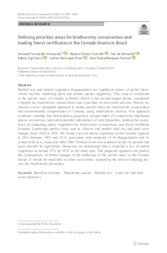Defining priorities areas for biodiversity conservation and trading forest certificates in the Cerrado biome in Brazil.
Defining priorities areas for biodiversity conservation and trading forest certificates in the Cerrado biome in Brazil.
Author(s): SCHWAIDA, S. F.; CICERELLI, R. E.; ALMEIDA, T.; SANO, E. E.; PIRES, C. H.; RAMOS, A. P. M.
Summary: Abstract Habitat loss and natural vegetation fragmentation are significant causes of global biodiversity decline, impacting plant and animal species negatively. This issue is worrisome in the private areas of Cerrado in Brazil, which is the second-largest biome, considered a hotspot for biodiversity conservation, and a provider of ecosystem services. Herein, we present a novel integrated approach to define priority areas for biodiversity conservation and environmental compensation in Cerrado, using multicriteria analysis. Our approach combines variables like deforestation projection, integral index of connectivity, threatened species occurrence, and environmental information of rural properties, ranking the importance of remaining native vegetation for biodiversity conservation and forest certificate issuance. Landscape metrics were used to observe and predict land use and land cover changes from 1988 to 2038. We found a loss of native vegetation in the Cerrado superior to 20% between 1988 and 2018, associated with increased of its fragmentation and its connectivity loss, especially after 2008. Natural cover was replaced mostly by pasture and more recently by agriculture. Moreover, we determined that is expected a loss of native vegetation of around 55% by 2038 in the study area. The proposed approach can predict the consequences of future changes in the landscape of the private areas in the Cerrado biome. It should be replicated in other ecosystems, supporting the decision-making process for biodiversity protection.
Publication year: 2023
Types of publication: Journal article
Unit: Embrapa Cerrados
Keywords: Cerrado, Espécies ameaçadas, Uso da Terra
Observation
Some of Embrapa's publications are published as ePub files. To read them, use or download one of the following free software options to your computer or mobile device. Android: Google Play Books; IOS: iBooks; Windows and Linux: Calibre.
Access other publications
Access the Agricultural Research Database (BDPA) to consult Embrapa's full library collection and records.
Visit Embrapa Bookstore to purchase books and other publications sold by Embrapa.

